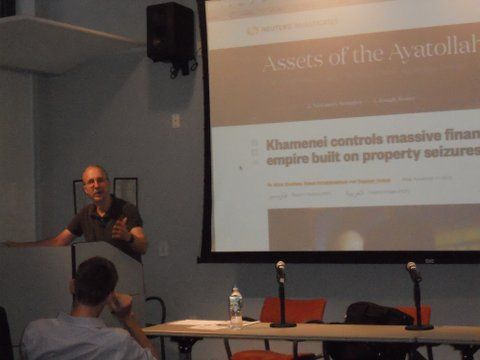In journalism, nothing has changed and everything has changed. That was the core message of an Overseas Press Club seminar with Pulitzer Prize-winning investigative reporter Steve Stecklow of Reuters on Monday, June 23, at the CUNY Graduate School of Journalism.
A video of the event will be posted on the OPC website, the first of what we hope will be a robust archive of training exercises.
Along with his team at Reuters, the veteran reporter won a 2013 Malcolm Forbes Award for a three-part series exposing an obscure Iranian organization, headed by Supreme Leader Ayatollah Ali Khamenei, that amassed a $95 billion empire largely from confiscated property. And they did the whole series without setting foot in Iran.
Iran forced Reuters to close its Tehran bureau in 2012, so Stecklow had to use every trick in his bag to chase down sources and documents for what he said was the most challenging project he’d ever worked on. Stecklow, who works at Reuters London bureau, blended shoe-leather wisdom with some of his best digital trade secrets during the seminar. “With investigative reporting, the three tools are persistence, persistence and persistence,” he told attendees.
Stecklow launched the six-month investigation into the financial juggernaut known as Setad by hunting down former employees of the shadowy organization and its holdings. He said ex-employees are more likely to talk freely and usually still have contacts at their previous job. Such people often squirrel away “CYA files,” he said, like contracts and other internal documents that could prove useful after they leave. He managed to obtain a PowerPoint presentation that outlined the entire structure of Setad, including names and job titles of executives.
As with all stories, he said, most of the work focused on tracking down primary documents, sources and victims of Setad’s property seizures. Fortunately for journalists, the tools to do so have grown more powerful in recent years.
By tuning the settings of a premium account on LinkedIn, and using advanced Google searches to penetrate websites, he tracked down sources that proved critical to the story. He used archive.org’s Wayback Machine to examine how Iranian websites appeared in the past. By scraping a Persian auction site with a program for Apple devices called SiteSucker, he found examples of confiscated properties that Setad had sold off. With domaintools.com, he found website registration information that included phone and email contact information for Setad’s headquarters.

Once Stecklow and his team – which included Babak Dehghanpisheh and Yeganeh Torbati – located sources, they traveled widely to meet in person outside of Iran. “It’s still better to talk to them face to face, and that hasn’t changed at all,” he said.
How did he feel about his digital sleuthing? “As a citizen, I’m outraged by how all this information is out there, but as a reporter it’s the greatest gift of all time,” he said.
